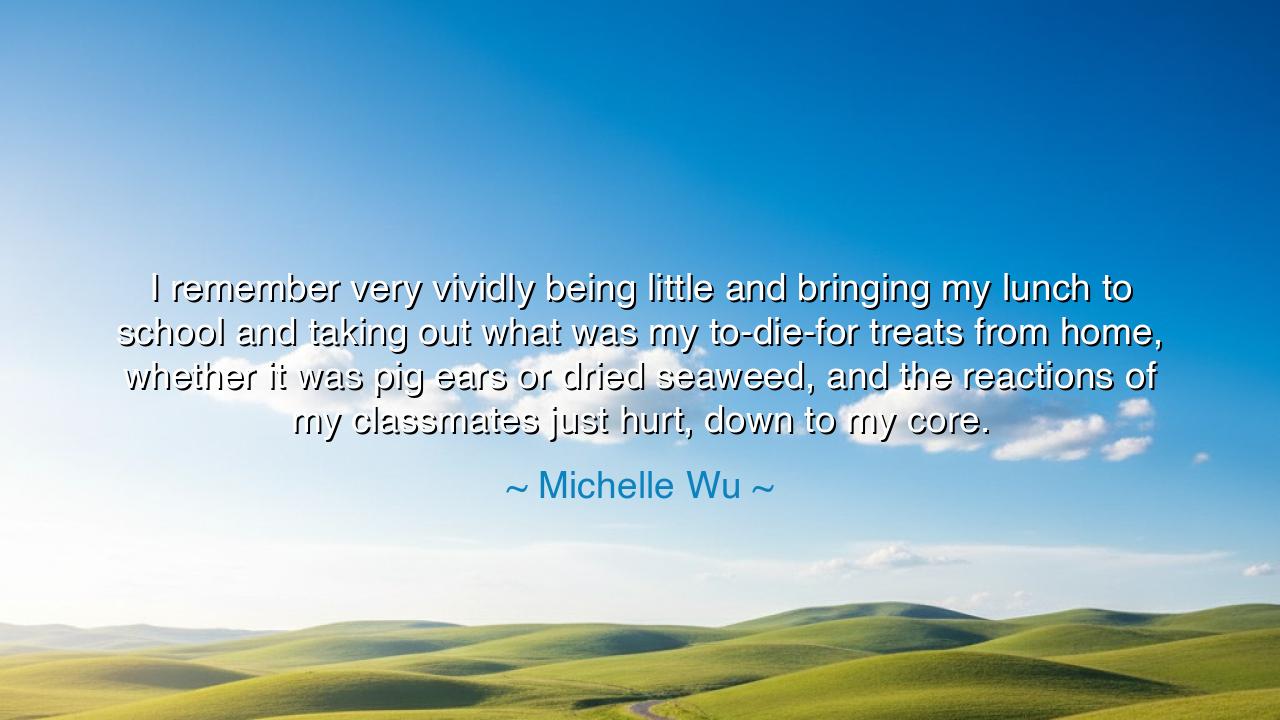
I remember very vividly being little and bringing my lunch to
I remember very vividly being little and bringing my lunch to school and taking out what was my to-die-for treats from home, whether it was pig ears or dried seaweed, and the reactions of my classmates just hurt, down to my core.






In the ledger of childhood, some wounds are small to the eye yet vast to the heart. So speaks Michelle Wu: “I remember very vividly being little and bringing my lunch to school and taking out what was my to-die-for treats from home, whether it was pig ears or dried seaweed, and the reactions of my classmates just hurt, down to my core.” The line descends like a bell into quiet water. It names a familiar trial for many children of immigrants: the moment when the food that carries your family’s love becomes a target, and you learn—too early—that taste can be weaponized and belonging made conditional.
Hear the meanings braided within. Lunch is not merely a meal; it is a portable archive—recipes saved through scarcity, seasons stored in salt and spice, ancestry folded into paper and string. Home travels to school in a small box, asking for nothing more than a corner of the table. Yet the classmates’ faces, schooled by other flavors and narratives, mirror back surprise, mockery, or pity. The child who cherished pig ears and dried seaweed—delicacies, textures of celebration—suddenly stands at the gates of a strange city where her passport is laughed at. This is why it hurts “down to my core”: the body is told that what nourishes it is unworthy.
The origin of such pain lies not in a single cafeteria but in an old pattern: the majority names itself normal, then names the rest other. In one century, it was garlic on the breath of new Italians; in another, tortillas warmed in foil, kimchi in mason jars, curry’s gold on fingers. Each era finds new ways to rehearse the same lesson: when we do not teach our young that taste is plural, they learn to police it. The to-die-for treats of one house become the punchline of another, and a child learns to hide what should have been held up to the light.
Let a story walk beside Wu’s, so the teaching wears sandals. In a New York classroom a century ago, a Sicilian boy opened a pail fragrant with sardines and fennel. Laughter rose; a teacher wrinkled her nose. That night his mother, proud of her seaside skill, learned that her cooking brought her son shame. She replaced sardines with white bread and sugar—the “American” lunch—and the boy stopped flinching at noon. He also stopped speaking Sicilian at home. Years later, as a baker, he would return to anise and oil, but he never forgot the first exile: not from a nation, but from a flavor. Thus the small stage of the table rehearses the drama of identity itself.
There is also a counter-song, an antidote born of hospitality. A teacher in present times, knowing the tyranny of the school lunchroom, set Wednesday aside as “heritage bites.” Children presented one ingredient, one story. A girl with dried seaweed explained tides and toasting; a boy with injera taught how bread becomes utensil; another with pig ears spoke of nose-to-tail thrift and feast days. The room learned to trade curiosity for contempt. Not every child converted to every taste, but all learned to bless without pretending. In such rituals, the border between home and school softens, and the table becomes a commons.
What, then, is the wisdom to pass down? First, that the heart’s pantry is sacred; vilifying food is often a rehearsal for vilifying people. Second, that esteem grows where understanding is fed: a minute of story can turn a grimace into a nod. Third, that children should never have to choose between home and belonging. The measure of a classroom is not only test scores, but whether a child may open their lunch without armor.
Take these actions as provisions. (1) For families: rehearse a proud script—two sentences a child can say when questioned about their food; pack a small “offer bite” to turn interrogation into invitation. (2) For teachers: build monthly “food lore” circles; grade not on persuasion but on explanation and listening. (3) For schools: adopt clear norms against mockery at meals; post them where trays are carried, not just where rules are read. (4) For communities: host potlucks where elders tell the origin of one dish—migration, drought, celebration—so that flavor is bound to memory, not stereotype. (5) For all of us: when we meet a new taste, let our first words be, “Tell me the story.” Curiosity is the hinge that turns a cafeteria into a table.
Remember: a child’s to-die-for treats are a family’s love letter written in salt and steam. If we teach our young to read that letter with respect, they will grow into elders who can stand in any marketplace, brave and tender, passing the bowl with both hands—never hiding, never shaming, always welcoming the next story to the feast.






AAdministratorAdministrator
Welcome, honored guests. Please leave a comment, we will respond soon